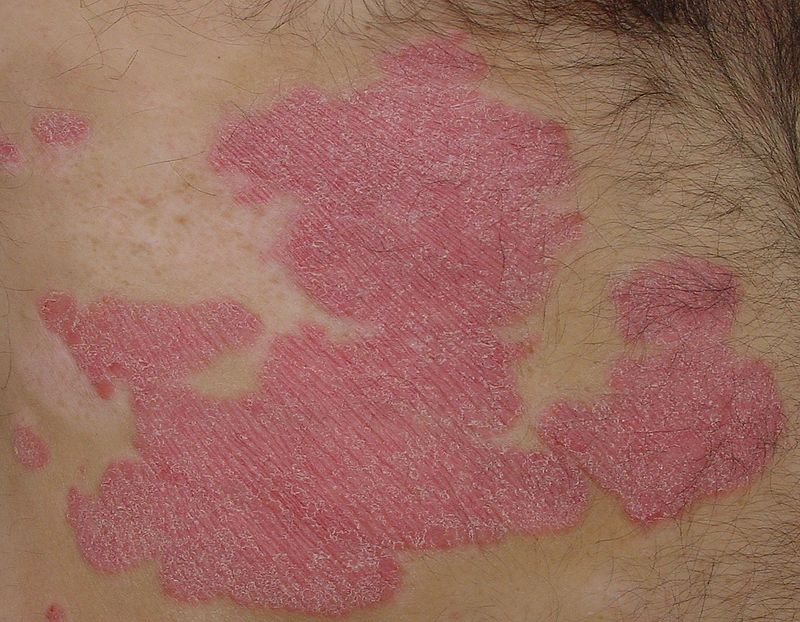Difference Between Plaque Psoriasis and Psoriasis
Key Difference – Plaque Psoriasis vs Psoriasis
Psoriasis is one of the most common dermatological problems that can have adverse effects on both social and mental well-being of the patient. It is an autoimmune condition whose pathogenesis is triggered by different intrinsic and extrinsic factors. Psoriasis can be defined as a chronic multisystem disease with skin and joint manifestations. There are different forms of psoriasis including guttate psoriasis, pustular psoriasis, etc. Out of them, plaque psoriasis is the commonest form of psoriasis which is characterized by the appearance of reddish well-demarcated plaques with silver scales usually on the extensor surface of the knees and elbows. So plaque psoriasis is one element of psoriasis which can have various other clinical manifestations. This is the key difference between Plaque Psoriasis and Psoriasis.
CONTENTS
1. Overview and Key Difference
2. What is Psoriasis
3. What is Plaque Psoriasis
4. Similarities Between Plaque Psoriasis vs Psoriasis
5. Side by Side Comparison – Plaque Psoriasis vs Psoriasis in Tabular Form
6. Summary
What is Psoriasis?
Psoriasis is a chronic multisystem disease with skin and joint manifestations.
Precipitating Factors
- Trauma
- Infection
- Hormonal imbalances such as hypoparathyroidism
- Drugs such as antimalarials and beta blockers
- Cigarette smoking and alcohol
Histological Features
- Parakeratosis
- Irregular thickening of the epidermis. But the epidermis over the dermal papillae is depleted which results in bleeding when scratched or the scales are removed. This is called the auspitz
- Polymorphonuclear leukocyte microabscesses
- Dilated and tortuous capillary loop
- Infiltration of the upper epidermis by T lymphocytes
Clinical Features
- Presence of plaques
- Scaling
- Erythema
- Pustules can appear sometimes on the skin of plantar and palmar surfaces
- Pitting of nails
The onset of psoriasis happens usually in the early adulthood. In pediatric cases the presentation is atypical.
There can be a family history of psoriasis. Any physiological stress such as trauma and infection can trigger the pathological processes that give rise to this condition. A hallmark feature of psoriasis is the Koebner’s phenomenon where the lesions first appear at a site of minor trauma. These lesions are not itchy and the exposure to the sun clears them. Associated arthropathy is a common comorbidity.
Different Forms of Psoriasis
Guttate Psoriasis
This usually occurs in adolescents within few weeks after a hemolytic streptococcal infection. The lesions disappear spontaneously.
Pustular Psoriasis
Can occur as chronic deep-seated lesions or generalized pustular psoriasis
Flexural Psoriasis
This is the form of psoriasis that occurs in places such as submammary, axillary and anogenital folds. Scales are rare, but there is a characteristic glistening nature.
Napkin Psoriasis
This appears in the area covered by the diapers. Babies who get napkin psoriasis are more likely to get psoriasis in the adult life.
Erythrodermic Psoriasis
Erythrodermic psoriasis is a rare form of psoriasis which is triggered by the irritant effect of chemicals such as tar.
Complications of Psoriasis
- Psoriatic arthropathy
Arthritis is a common complication of psoriasis which is approximately seen among 5% of the psoriatic patients. Usually, the terminal interphalangeal joints of the toes and fingers are affected. In some occasions, the symptoms and clinical features of psoriatic arthropathy mimic rheumatoid arthritis in which case large joints such as sacroiliac joint are affected.
Investigations
- Biopsies are rarely done
- In Guttate psoriasis, throat swabs are taken to find the presence of beta-hemolytic streptococci
- Skin scrapings and nail clippings are required to exclude tinea
- Radiography is necessary to assess the associated arthropathy

Management
- Drugs such as Vitamin D analogs, calcipotriol and tacalcitol can be given
- UV radiation therapy
- Treatment with local retinoids or local corticosteroids
What is Plaque Psoriasis?
Plaque psoriasis is the commonest form of psoriasis which is characterized by the appearance of reddish well-demarcated plaques with silver scales usually on the extensor surface of the knees and elbows. Lower back, scalp, and ears are the other common sites affected by this condition. New plaques can emerge at the sites of new trauma. This is known as the Kbner phenomenon. Occasionally the lesions can become itchy or sore.

Plaque psoriasis is managed in the same manner as mentioned above.
What are the Similarities Between Plaque Psoriasis and Psoriasis?
- Both have the same pathogenesis
- Different forms of psoriasis are managed in the same manner
What is the Difference Between Plaque Psoriasis and Psoriasis?
Recursion vs Iteration | |
| Psoriasis is a chronic multisystem disease with skin and joint manifestations. | Plaque psoriasis is the commonest form of psoriasis which is characterized by the appearance of reddish well-demarcated plaques with silver scales usually on the extensor surface of the knees and elbows. |
Summary – Plaque Psoriasis vs Psoriasis
Psoriasis is a chronic multisystem disease with skin and joint manifestations. Plaque psoriasis is the commonest form of psoriasis which is characterized by the appearance of reddish well-demarcated plaques with silver scales usually on the extensor surface of the knees and elbows. Accordingly plaque psoriasis is one manifestation of the broad spectrum of dermatological and systemic manifestations which are identified as psoriasis. This can be identified as the difference between plaque psoriasis and psoriasis.
Download the PDF Version of Plaque Psoriasis vs Psoriasis
You can download PDF version of this article and use it for offline purposes as per citation note. Please download PDF version here Difference Between Psoriasis and Plaque Psoriasis
Reference:
1.Buxton, Paul K. ABC of dermatology. London: BMJ, 2007
Image Courtesy:
1.’Psoriasis infliximab ar1182-2’By Amber Y Goedkoop, Maarten C Kraan, Daisy I Picavet, Menno A de Rie, Marcel BM Teunissen, Jan D Bos and Paul P Tak, (CC BY 2.0) via Commons WikimediancG1vNJzZmivp6x7pbXFn5yrnZ6YsqOx07CcnqZemLyue8OinZ%2Bdopq7pLGMm5ytr5Wau268y5qorp1dpcCwvsiaqqKrXZa7pXnVrGSpq5%2BntqK%2FyKxm